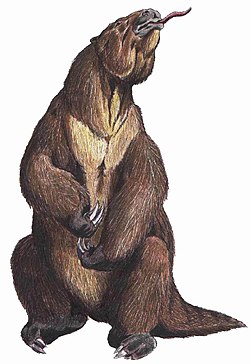| Meizonyx Temporal range: | |
|---|---|
| Scientific classification | |
| Domain: | Eukaryota |
| Kingdom: | Animalia |
| Phylum: | Chordata |
| Class: | Mammalia |
| Order: | Pilosa |
| Family: | † Megalonychidae |
| Genus: | † Meizonyx Webb & Perrigo, 1985 |
| Species: | †M. salvadorensis |
| Binomial name | |
| †Meizonyx salvadorensis Webb & Perrigo, 1985 | |
Meizonyx is an extinct genus of megalonychid ground sloth from the Pleistocene of El Salvador and southern Mexico. The type and only species, Meizonyx salvadorensis, was described in 1985 from a mandible found in Barranca del Sisimico and other remains found at Rio Tomayate in El Salvador considered to be Middle Pleistocene in age. [1] Later, in 2021, two partial skeletons were described from Late Pleistocene aged deposits in Sistema Huautla cave in, Oxaca, Mexico, with one of these dating to around 12,562 ± 130 years Before Present. It is considered closely related to Xibalbaonyx. [2] It is thought to be comparable or somewhat greater in size than Megalonyx jeffersonii. It inhabited relatively mountainous areas. [3]

